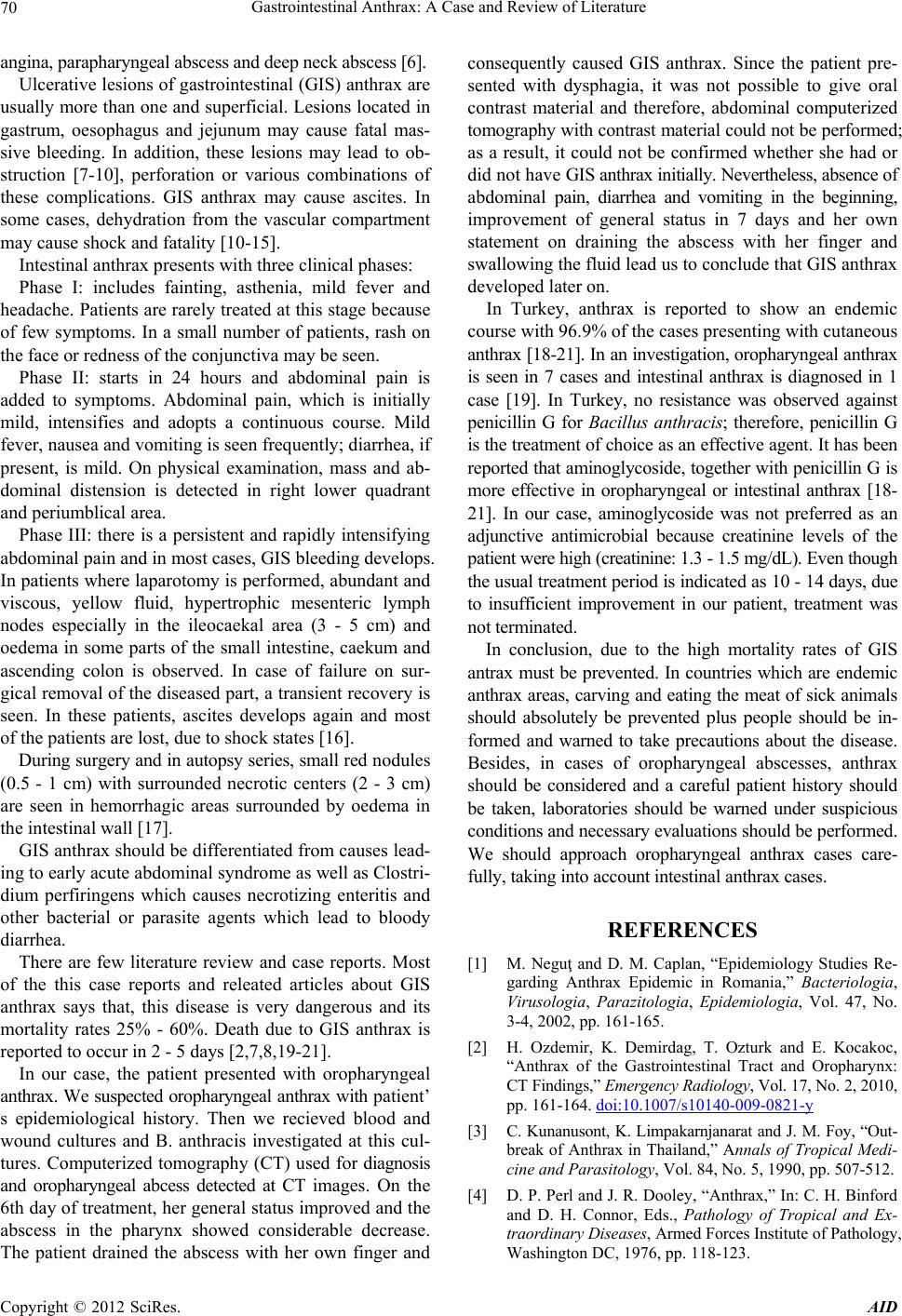
Gastrointestinal Anthrax: A Case and Review of Literature
70
angina, parapharyngeal abscess and deep neck abscess [6].
Ulcerative lesions of gastrointestinal (GIS) anthrax are
usually more than one and superficial. Lesions located in
gastrum, oesophagus and jejunum may cause fatal mas-
sive bleeding. In addition, these lesions may lead to ob-
struction [7-10], perforation or various combinations of
these complications. GIS anthrax may cause ascites. In
some cases, dehydration from the vascular compartment
may cause shock and fatality [10-15].
Intestinal anthrax presents with three clinical phases:
Phase I: includes fainting, asthenia, mild fever and
headache. Patients are rarely treated at this stage because
of few symptoms. In a small number of patients, rash on
the face or redness of the conjunctiva may be seen.
Phase II: starts in 24 hours and abdominal pain is
added to symptoms. Abdominal pain, which is initially
mild, intensifies and adopts a continuous course. Mild
fever, nausea and vomiting is seen frequently; diarrhea, if
present, is mild. On physical examination, mass and ab-
dominal distension is detected in right lower quadrant
and periumblical area.
Phase III: there is a persistent and rapidly intensifying
abdominal pain and in most cases, GIS bleeding develops.
In patients where laparotomy is performed, abundant and
viscous, yellow fluid, hypertrophic mesenteric lymph
nodes especially in the ileocaekal area (3 - 5 cm) and
oedema in some parts of the small intestine, caekum and
ascending colon is observed. In case of failure on sur-
gical removal of the diseased part, a transient recovery is
seen. In these patients, ascites develops again and most
of the patients are lost, due to shock states [16].
During surgery and in autopsy series, small red nodules
(0.5 - 1 cm) with surrounded necrotic centers (2 - 3 cm)
are seen in hemorrhagic areas surrounded by oedema in
the intestinal wall [17].
GIS anthrax should be differentiated from causes lead-
ing to early acute abdominal syndrome as well as Clostri-
dium perfiringens which causes necrotizing enteritis and
other bacterial or parasite agents which lead to bloody
diarrhea.
There are few literature review and case reports. Most
of the this case reports and releated articles about GIS
anthrax says that, this disease is very dangerous and its
mortality rates 25% - 60%. Death due to GIS anthrax is
reported to occur in 2 - 5 days [2,7,8,19-21].
In our case, the patient presented with oropharyngeal
anthrax. We suspected oropharyngeal anthrax with patient’
s epidemiological history. Then we recieved blood and
wound cultures and B. anthracis investigated at this cul-
tures. Computerized tomography (CT) used for diagnosis
and oropharyngeal abcess detected at CT images. On the
6th day of treatment, her general status improved and the
abscess in the pharynx showed considerable decrease.
The patient drained the abscess with her own finger and
consequently caused GIS anthrax. Since the patient pre-
sented with dysphagia, it was not possible to give oral
contrast material and therefore, abdominal computerized
tomography with contrast material could not be performed;
as a result, it could not be confirmed whether she had or
did not have GIS anthrax initially. Nevertheless, absence of
abdominal pain, diarrhea and vomiting in the beginning,
improvement of general status in 7 days and her own
statement on draining the abscess with her finger and
swallowing the fluid lead us to conclude that GIS anthrax
developed later on.
In Turkey, anthrax is reported to show an endemic
course with 96.9% of the cases presenting with cutaneous
anthrax [18-21]. In an investigation, oropharyngeal anthrax
is seen in 7 cases and intestinal anthrax is diagnosed in 1
case [19]. In Turkey, no resistance was observed against
penicillin G for Bacillus anthracis; therefore, penicillin G
is the treatment of choice as an effective agent. It has been
reported that aminoglycoside, together with penicillin G is
more effective in oropharyngeal or intestinal anthrax [18-
21]. In our case, aminoglycoside was not preferred as an
adjunctive antimicrobial because creatinine levels of the
patient were high (creatinine: 1.3 - 1.5 mg/dL). Even though
the usual treatment period is indicated as 10 - 14 days, due
to insufficient improvement in our patient, treatment was
not terminated.
In conclusion, due to the high mortality rates of GIS
antrax must be prevented. In countries which are endemic
anthrax areas, carving and eating the meat of sick animals
should absolutely be prevented plus people should be in-
formed and warned to take precautions about the disease.
Besides, in cases of oropharyngeal abscesses, anthrax
should be considered and a careful patient history should
be taken, laboratories should be warned under suspicious
conditions and necessary evaluations should be performed.
We should approach oropharyngeal anthrax cases care-
fully, taking into account intestinal anthrax cases.
REFERENCES
[1] M. Neguţ and D. M. Caplan, “Epidemiology Studies Re-
garding Anthrax Epidemic in Romania,” Bacteriologia,
Virusologia, Parazitologia, Epidemiologia, Vol. 47, No.
3-4, 2002, pp. 161-165.
[2] H. Ozdemir, K. Demirdag, T. Ozturk and E. Kocakoc,
“Anthrax of the Gastrointestinal Tract and Oropharynx:
CT Findings,” Emergency Radiology, Vol. 17, No. 2, 2010,
pp. 161-164. doi:10.1007/s10140-009-0821-y
[3] C. Kunanusont, K. Limpakarnjanarat and J. M. Foy, “Out-
break of Anthrax in Thailand,” Annals of Tropical Medi-
cine and Parasitology, Vol. 84, No. 5, 1990, pp. 507-512.
[4] D. P. Perl and J. R. Dooley, “Anthrax,” In: C. H. Binford
and D. H. Connor, Eds., Pathology of Tropical and Ex-
traordinary Diseases, Armed Forces Institute of Pathology,
Washington DC, 1976, pp. 118-123.
Copyright © 2012 SciRes. AID